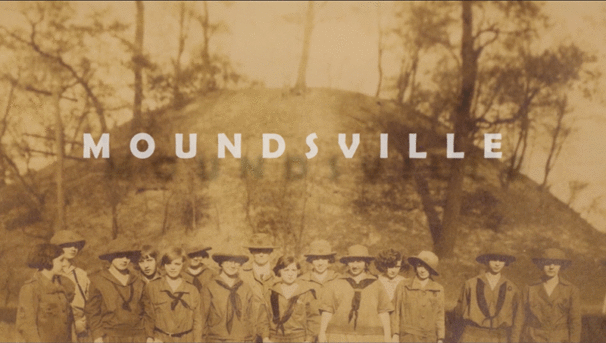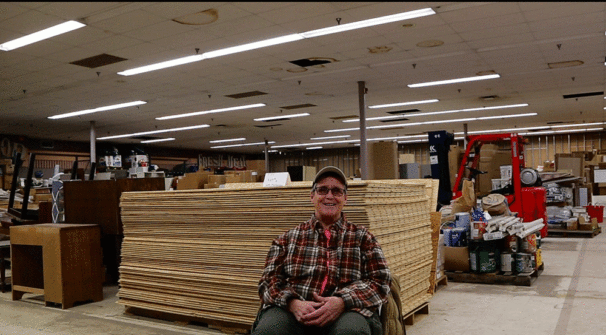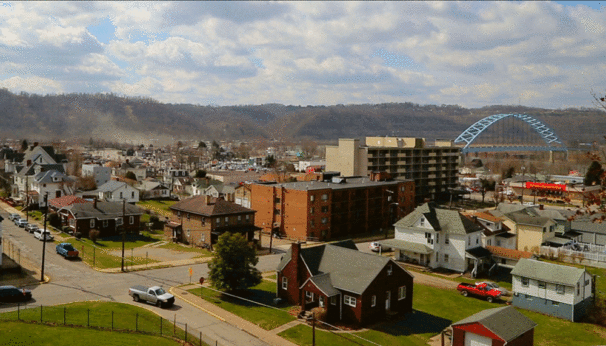
The 2018 documentary Moundsville drops viewers into the West Virginia town with no introduction. Instead, the film takes us directly into conversations with local residents, the mayor, a former mayor, retirees, a couple of historians, young entrepreneurs—a dozen or so people from all walks of life. They talk about the town’s history, the prehistoric burial mound for which it is named, the leading industries over the decades, the boom times, the economic decline since the 1980s, and ideas about the town’s future. I grew up in the Ohio Valley, about an hour’s drive from Moundsville, so these conversations felt familiar, like spending an afternoon in the local diner.
 A central theme is the local economy, including the remarkable number of products that the town’s workers manufactured in decades past. At one time, Marx Toys, which employed thousands in its Glen Dale factory (neighboring Moundsville), produced one of every three toys made in America. Other major employers in the area included Fostoria Glass, U.S. Stamping Company, Allied Chemical, and the Moundsville State Penitentiary. A short drive away were coal mines, steel mills, and more chemical plants.
A central theme is the local economy, including the remarkable number of products that the town’s workers manufactured in decades past. At one time, Marx Toys, which employed thousands in its Glen Dale factory (neighboring Moundsville), produced one of every three toys made in America. Other major employers in the area included Fostoria Glass, U.S. Stamping Company, Allied Chemical, and the Moundsville State Penitentiary. A short drive away were coal mines, steel mills, and more chemical plants.
Today, Moundsville’s economy—like much of the region’s—looks a lot different. Many of the mines and mills have shut down. RV parks just out of town house out-of-state gas pipeline and drilling crews. The downtown has a lot of old businesses but also empty storefronts, and the Walmart Supercenter and other chain stores on the edge of town have won over many customers. Some local entrepreneurs have found their niche in the new economy by, among other things, capitalizing on tourism to the now shuttered prison and the nearby Palace of Gold (a Hare Krishna community). But a third of the town’s residents have moved away.
With so many rusting factories, Moundsville could have become just another of the many reports from “Trump Country” since the 2016 election. Most of those seem to be written by journalists facing deadlines, who parachute into Appalachia, gather a few quotes that support their assumptions about racist provincials, and then head back to the airport. In her recent book What You Are Getting Wrong About Appalachia, Elizabeth Catte writes that these reports “share a willingness to use flawed representations of Appalachia to shore up narratives of an extreme ‘other America’ that can be condemned or redeemed to suit one’s purpose.”

Those reports often attempt to construct a single narrative about voters in “Trump Country,” and the makers of Moundsville explicitly position their documentary against such narratives. The voiceover for one of the trailers for the documentary explains that after the election “every media story about small-town America seemed to focus on the same things: Trump, opioids, and the rusting factory.” “But,” it continues, “what if you went to a small town and didn’t talk about those things? What if you simply asked people about their lives without connecting their answers to those larger narratives?”
Indeed, Moundsville does a good job of capturing the joys of life in a small town and highlighting the diversity of voices even in a town of 9000 by featuring young and old, women and men, and white, African American, and Latino voices.
While this portrait is refreshing because the filmmakers brought empathy and patience to the project, they left out some important, complex, and challenging topics that do not lend themselves to restaurant conversations. While the documentary touches on economic decline, trade policies, and the outmigration of young people, it tends to treat economic change as natural or neutral, not even mentioning the policymakers or policies that facilitated capital migration. I would argue that one of the greatest accomplishments of the proponents of neoliberalism has been to make their ideology seem like economic changes just happen. Neoliberals’ free-trade policies, cuts to taxes and social spending, privatization, and the elimination of union protections have hollowed out many factory towns, cut assistance to the poor and unemployed, and concentrated wealth and power in the hands of the few.
While some of the participants in the documentary share their memories of Moundsville’s prosperous decades, they don’t talk about how unions enabled workers to address safety concerns and gender discrimination, win fair wages and benefits, bring stability to their families, buy homes, and have discretionary income to spend at local businesses. While the residents remember those prosperous years by listing employers, they don’t mention the American Flint Glass Workers’ Union, the United Steel Workers of America, the Oil, Chemical and Atomic Workers Union, and the United Mine Workers of America. I’m guessing that only a few of those interviewed were union members, and as union strength has declined since the 1980s, public memories of the critical role they played in earlier decades have faded.

Also, Moundsville offers only a cursory discussion of race and racism. A former mayor, who is African American, recalls painful episodes of racism when he was growing up but says that he no longer faces that kind of cruelty. And the Latino owner of the Acapulco Mexican Restaurant says that racism is still present and that it negatively frames residents’ understanding of immigrants. We do not hear other residents’ thoughts on the role of race in their town’s history. While Moundsville avoids the overly simplistic, stereotypical portraits of racist hillbillies that are a common feature of “Trump Country,” the result is to largely ignore race and racism, which are admittedly complex subjects.
Growing up in northern West Virginia, I was largely unaware of racism and associated it most with the use of the N-word, which was only uttered by the crudest students at my school. It was not until I reached adulthood that I began to realize that racism was particularly powerful when it was unheard and unseen. Racism has shaped life in these Ohio Valley factory towns in fundamental ways, particularly through discriminatory housing, employment, and education, and sometimes as a result of battles fought decades ago. These forms of racism are pervasive throughout the United States—no region or social class has a monopoly on it—and institutional racism’s profound effects up through the present need to be better understood.
When we erase subjects like institutional racism, the labor movement, and the rise of neoliberalism, the resulting portrait is incomplete, and things seemingly just happen to people and towns with no understanding of why. Moundsville is an intimate portrait of a former factory town whose residents are proud of their hometown and working to redefine it, and I appreciate the filmmakers’ hard work and empathetic lens. Yet much work remains to help us make sense of the past and present of Moundsville and many places like it.
The trailer can be viewed here.
This is an excerpted version of an article that originally appeared at the Working-Class Perspectives site, hosted by Georgetown University’s Kalmanovitz Initiative for Labor and the Working Poor.










